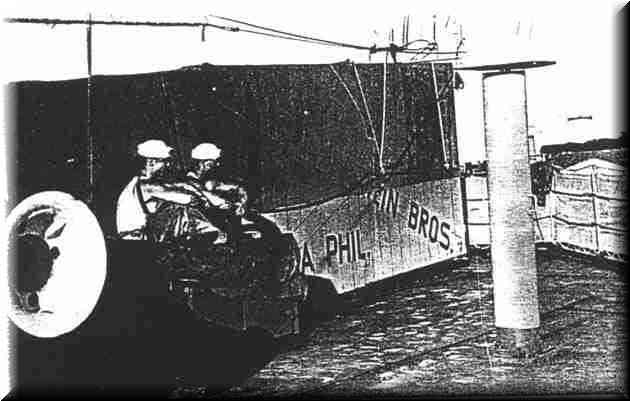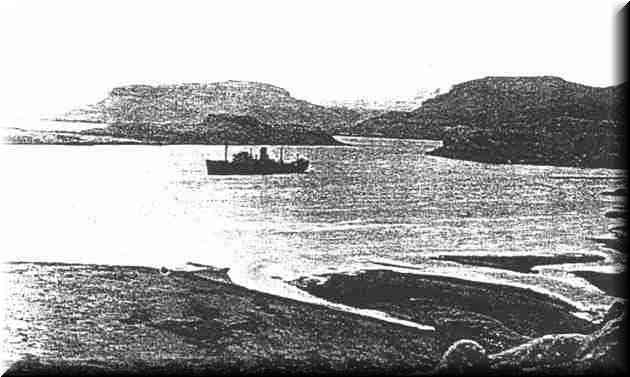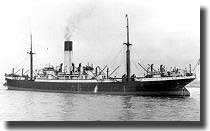|
Marauders of the Sea, German Armed Merchant Ships During W.W. 2
Atlantis Atlantis (Ship 16) Rogge gave her the name "Atlantis." the first of a proposed nine disguised cornmerce raiders planned to operate in two separate waves. The I939-l940 winter in Europe was a particularly severe one. The proposed German offensive in the west was postponed many times due to the prevailing appaling weather. Thus, Rogge and his 'Atlantis' could not sail for trials until March 31 1940, a month later than planned. The former battleship "Hiessen" launched in 1903, had fought at Jutland, and was now serving as a radio controlled target vessel was set to act as an icebreaker. With some difficulty she forced a passage for herself and "Atlantis" plus two other raiders, "Widder," and "Orion" into the North Sea. Timing was paramount, waters of the far north were usually deserted, but the imminent German attack on Norway would, no doubt, attract the attention of the British Home Fleet. "Atlantis" sailed only a week before German forces departed for the Norway Campaign and was disguised as the "Krim," a Russian auxiliary warship. "Atlantis," with the help of a blizzard and misty weather worked her way undetected down the Greenland coast and by April 24-25 had crossed the equator. As a Russian ship was very unlikely to be sailing in these waters, she became the Japanese 8,400 ton "Kasii Maru.'' This formidable raider captained by a most resourceful officer carried 6 by 5.9 inch guns hidden behind collapsible bulkheads. one 75 millimeter gun, 6 light AA guns, 4 torpedo tubes and 92 mines, plus a Heinkel 114 seaplane . Rogge was a master of disguises for his ship, having, at different times, posed as a British, Russian, Japanese, Norwegian or Netherland's ship. Children from ships sunk were used on the upper deck as a screen, a few passengers, including a woman with a pram paraded the Boat Deck.
![[Image]](../qships/g7.jpg) "H.M.S. DEVONSHIRE" - Entering Freetown Harbour, West Africa, after Sinking the "Atlantis" Rogge had sailed the South Atlantic, the Indian Ocean, overhauled at the remote Kerguelen Island, then into Asian waters off Singapore, and the Dutch Fast Indies. In March or 1941, The "Atlantis" had been at sea for a year, and her Captain had received the award of the Knight's of the Iron Cross. He was ordered to head from the South Atlantic to the Pacific, via South of Australia and well East of New Zealand. When 100 miles North East of Pitcairn Island, on the 18th. of October, 1941, Rogge was at last told to sail for home via Cape Horn. He was to rendez-vous with U-Boat 68, 500 miles South of St.Helena, refuel her, then give the same service to U-Boat U126, North of Ascension Island. Rogge had circumnavigated the globe. He met U68 on the 13th. of November , fuelled her, then sailed off to meet U126, who appeared alongside on the 22nd. of November.
 Supposed industrial machinery for the Philippines At that time, Navigators relied on sun and star sights to find their way around the oceans of the world, no such luxury as pressing a button on the bridge, to fix one's ship by satellite. Rogge and his Officers were always able to pinpoint their position, so that they could meet their countrymen at a prearranged spot on the vast oceans they roamed and called Home. "Atlantis," and U126 drifted blissfully on, the U-Boat Captain on board "Atlantis" having been seduced to go there by the offer of a hot bath and this temptation proved too much for him. In "Atlantis," a lookout suddenly reported a British Cruiser of the London Class in sight (it was H.M.S. ''Dorsetshire") and the First Lieutenant of U126, dived his Boat, leaving his Captain stranded in the bath, onboard "Atlantis." "Devonshire" kept her distance, opening fire at extreme range, "Atlantis" stopped, posing as the British ship, "Polyphemus" and transmitted RRR in groups of three letters, not realising that recent orders to Allied ships had changed this proceedure, and the RRR signal should now be sent as RRRR in groups of four letters.
![[Image]](../qships/Industrialmachinerytransforms.jpg) Industrial machinery transforms into lethal 5.9 inch gun.Supposed industrial machinery for the Philippines "Devonshire," now steaming at high speed, fired 3 by 8 inch salvoes at a range of I 7,000 yards. The first fell short, shells from the second and third salvoes hit, the German Ship's magazine exploded, and she quickly sank. Her whole crew were in the water. Because of U-Boat threats, "Devonshire," now made off at high speed. Rogge marshalled his crew to find out that 7 were missing. U126 surfaced, and her embarassed Captain took his rightful place in Command, and 113 of the Raider's crew were taken on board, 113 were placed on the U-Boat's deck, 113 towed in boats and rafts, the remainder crowded below. Admiral Donitz, in France, organised a rescue package. 3 U-Boats and the supply ship "Python." They picked up survivors on the night of 23/24 of November. "Python" was replenishing Boats on the surface on the 1st. of December when a second British 3 funnelled Cruiser appeared, this time, a sister ship to "Devonshire." It was "Dorsetshire." Many of this class were named after English Counties. They performed sterling service throughout the war, and proved to be:- "Maids of all types of work." They convoyed, searched for and destroyed German Raiders, were used as bombardment ships, their 8 by 8 inch guns packed a formidible wallop in their broadside. (3)
 Atlantis sheltering at Kergelen where 1000 tons of much needed water was loaded During the war I served in 3 of them in the Australian Navy, "Australia," the first ship to suffer damage from the new Japanese weapon, "Divine Wind," the Kamikaze attacks by suicide aircraft; in "Canberra" to be sunk alongside her American Allies "Quincy," "Astoria," and "Vincennes" who lost over 1,000 sailors on that fatetul night of August 9,1942 at the Battle of Savo Island in the Solomons. Winston Churchill arranged for the "Shropshire" to be given to the Royal Australian Navy as a gift, to replace "Canberra." Many or'Canbera's" survivors, including myself, crewed "Shopshire." She had a distinguished career in the Pacific working with a US task force, and I was onboard her for the Japanese surrender in Tokyo Bay on September 2, 1945. But I digress. The U-Boats all dived, "Python" was scuttled and quickly sank. On "Dorsetshire's" departure, the U-Boats surfaced and collected 414 survivors, each boat taking 100 men on board, and the rest were taken in tow in 10 life boats. Donitz had to organise a second rescue bid, and sent 8 submarines in the South Atlantic to seek out this flotilla of survivors. He sent 4 German, and 4 Italian Submarines. All of the survivors were picked up, some 360 spent 10 days being towed in their open boats, and a further 60 spent 20 days as they were towed to safety. All in all, it was a masterly rescue operation. As a bonus for the Germans, U-124, on her way to the rescue site, came across the British Cruiser "Dunedin," which she promptly sank. All the rescue Submarines with their human cargo made it back to St.Nazaire between December 23 and 29, and by New Year's day 1942, the "Atlantis" crew had gathered in Berlin for celebrations. Captain Bernard Rogge, and his Ship's Company bad been at sea from the 31st of March in 1940 until the 21st of November, 1941, a remarkable petrol of "622 days." They had sailed 102,000 miles, and sunk or captured 22 ships, totalling 145,697 tons. Indeed, a modern saga of the war at sea, Rogge received a just reward from Hitler, the Oak Leaves to the Knight's Cross of the Iron Cross. By the end of the war, he had reached the rank of Vice Admiral, and was second in command of the German Fleet.
In my Marauders of the Sea. WW2 (See Atlantis), I covered briefly the activities of the German Armed Merchant Raiders in WW2. The Atlantis under Captain Rogge was one of these, and in her career sank some 22 ships, the most important being SS Automedon, a 7,528 ton freighter built by Palmer's Shipbuilding and Iron Company at Jarrow in 1922 for the Blue Funnel Line from Liverpool. She was some 459 feet long with a 58 foot beam , designed for a speed of 14 knots. On the 11th. of November 1940, she was sailing between Nicobar Island and Ceylon bound for Singapore. Atlantis sighted her, closed to 4,000 yards and opened fire, hitting Automedon on the bridge killing all there including the Master, Captain W.B.Ewan. Although the freighter sent an initial distress signal, RRR Automedon, 0416N-- the first three letters of which indicated " under attack by armed raider " and two British ships Matara and Helenus read this signal, and sent off details of the attack to Singapore, the German Raider quickly destroyed Automedon's radio mast by accurate gunfire, stopping any further radio traffic. The ship was hit some 11 times before Atlantis ceased firing at her hapless victim. A lone woman, 312 crew plus 56 Chinese were taken onboard the Raider. First Lieutenant Ulrich Mohr, leading the boarding party, in the Chart Room came across a long narrow envelope enclosed in a green bag fitted with brass eyelets to allow water to enter, and sink it, in the event of its necessary disposal. This document was marked: "Highly Confidential .... To be Destroyed" its envelope marked to:"The Commander-in-Chief Far East.... To be Opened Personally." This highly sensitive, fascinating, and important document was drawn up by the Planning Division of the War Cabinet. It carried details of RAF units, details of Naval strength, an assessment of the role of Australia and New Zealand. A long appreciation regarding the possibility of Japan entering the war, and copious notes on the fortifications at Singapore. One of this document's most worrying aspects was about the inability of Britain to muster a Fleet to defend Singapore, as the Navy was at full stretch in its struggle with Germany and Italy. It stated that even if Japan attacked Indo China and Siam Britain would not intervene, and that Hong Kong would be abandoned. In short, this document stated that Singapore and Malaya could not survive a concentrated attack by Japan. But, why on earth, would such sensitive and important material be despatched in mail carried by an old freighter like Automedon? It could, or indeed should have been carried in an aircraft, or in one of HM ships of war. The Governor of the Straits Settlements in Singapore, Sir Shenton Thomas was on leave in UK, he could have carried this copy of the report personally home, and handed it to the new C-in C, Sir Robert Brookes Popham. Importantly, the British Government never made any papers about the loss of this important document available to the public. It clung to its secret that these papers were captured by the Germans, and must also be in Japanese hands. The Government must have known it had fallen into enemy hands, the two merchant ships had reported the attack on Automedon. One of her engineers, Samuel Harper, was sent as a POW to the ship Storsad, and arrived back at Bordeaux in January of 1941. He escaped from a train, crossed the Pyreenes, through Spain to reach Gibraltar on the 31st. of May 1941. He was debriefed by M16, all the circumstances of the loss of his ship to Atlantis were recorded. The British Government just had to know that their secret document was most likely in German hands and that it would be passed on to Japan. Post war, in 1948, Sir Robert Brookes Popham asked the embarassing question, "What happened to my copy of the report in 1940?" The pretence was maintained, he was told it had been sunk in a U-Boat attack and lost, and that it was not until 1945, after Germany had surrendered, that we realised that the German Submarine Commander had managed to obtain the secret documents from the ship before sinking it. The cover up about Atlantis obtaining this document continues post war. But, back to Captain Rogge, he understood English, and quickly realised what a gem had been captured. He despatched the document in the captured Norwegian ship Ole Jacob to arrive at Kobe Japan, a few weeks later. Vice Admiral Wenneker, the German Naval Attache in Japan read the document, and made this asssessment of it:
The original documents were now despatched off to Berlin at the rush. On its arrival there a copy was given to Hitler, who closely studied it, and then sent it off to the Japanese Naval Attache resident in Berlin, Captain Yokoi. Thus on the 12th. of December 1940, Yokoi sent a message to his Naval Staff in Tokyo:
The original copy was handed to Vice Admiral Kondo in Japan, he was at first sceptical of the findings, believing it was a ploy of the British to lull Japan into a false sense of security. But, when learning how the document was captured, he decided to accept the findings as legitimate. Japan thus had a year's warning before the outbreak of war, that Britain could not defend her Colony at Singapore. Admiral Wenneker in his War diary entry on the 12th. of December 1941 states:
But why was this War Cabinet assessment sent off to Singapore via a slow British freighter SS Automedon? We will never really know the answer to that question, but, one is tempted to think that Winston Churchill as the British Prime Minister with his country fighting for survival, the Battle of the Atlantic going Germany's way,. wanted the US desperately to enter this war. Was he hoping, even plotting for this document to be captured by Germany? If it was, it would soon be in the hands of Japan, he could not defend Singapore, was he provoking Japan to attack and occupy this Colony? with the hope of drawing the United States in on the side of the Allies. With the might of the US victory in due course would be assured. But what an incredible scenario! Conclusion. At last, Winston would be happy in the knowledge that with the US fighting alongside Britain and her Dominions, victory was now assured, it would be just a "Matter of time." next chapter |

